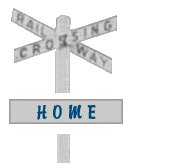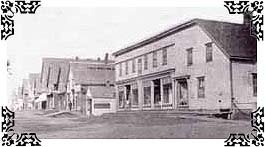









 While it had always
been a busy junction, Kensington came into its own as a
business district with the opening of the railway
in 1875. Until that time, the community of Margate
was the commercial outpost for the region, mainly due to
its proximity to the water. But the railway made quick
overland transportation into a reality. Its passage
through a community could almost singlehandedly touch off
a business boom, bringing with it an influx of trade for
merchants and more traffic for taverns and inns. When the
tracks bypassed Margate and ran through Kensington, local
commerce almost immediately shifted three miles west.
While it had always
been a busy junction, Kensington came into its own as a
business district with the opening of the railway
in 1875. Until that time, the community of Margate
was the commercial outpost for the region, mainly due to
its proximity to the water. But the railway made quick
overland transportation into a reality. Its passage
through a community could almost singlehandedly touch off
a business boom, bringing with it an influx of trade for
merchants and more traffic for taverns and inns. When the
tracks bypassed Margate and ran through Kensington, local
commerce almost immediately shifted three miles west.
![]()
Businessmen left the shoreline and began
resettling around the bustling rail station. One of the
most influential new arrivals was Reuben Tuplin, who
established a large mercantile business in Kensington.
His son-in-law, Dr. Donald Darrach, later purchased an
interest in the lucrative Tuplin enterprise, and also
started a pharmacy which housed the town's first
telephone. As well as being shrewd entrepreneurs, members
of the business community also allowed their names to
stand for political office. Many merchants became mayors,
councilmen, and members of the P.E.I. Legislature.
Reuben Tuplin | Dr.Donald
Darrach | James
Kennedy | Maynard
F. Schurman |
Russell Champion | Donald
MacKenzie | K.L.
Waite | Other
Pharmacies
 Tradespeople had been
plying their skills in Kensington ever since the first
settlements here. There was a blacksmith, Edwin Proctor,
as early as 1831, and a tailor based in Barrett's Cross
by 1833. But the decision to have the railway come
through Kensington, and the resulting increase of
settlers, almost guaranteed that its tradespeople would
flourish. Carriage builders and livery stable owners were
in demand since horses were still the main means of
transportation. Another essential craft was that of the
blacksmith, who kept the horses well-shod and fashioned
everything from farm tools to cooking utensils.
Tradespeople had been
plying their skills in Kensington ever since the first
settlements here. There was a blacksmith, Edwin Proctor,
as early as 1831, and a tailor based in Barrett's Cross
by 1833. But the decision to have the railway come
through Kensington, and the resulting increase of
settlers, almost guaranteed that its tradespeople would
flourish. Carriage builders and livery stable owners were
in demand since horses were still the main means of
transportation. Another essential craft was that of the
blacksmith, who kept the horses well-shod and fashioned
everything from farm tools to cooking utensils.
Blacksmith | Shoemaker | Tailor
and Dressmaker
| Livery Stable |
Herbert R. Moase, Tradesman
 As well as bringing new
business for merchants, the daily trains unloaded a
steady stream of visitors for the town's taverns and
hotels. In the 1820's, one of the first buildings at Five
Lane's End was the public house run by Thomas and
Margaret Barrett, who welcomed travelers on the Old Post
Road between Charlottetown and Summerside. Thomas Sims
continued this tradition of hospitality, operating a
beautiful hotel that even boasted its own brewery.
Relaxation did not necessarily mean revelry, though.
These inns were required by law to provide food service
as well, and soon restaurants appeared to tantalize the
tastebuds of visitors and residents alike.
As well as bringing new
business for merchants, the daily trains unloaded a
steady stream of visitors for the town's taverns and
hotels. In the 1820's, one of the first buildings at Five
Lane's End was the public house run by Thomas and
Margaret Barrett, who welcomed travelers on the Old Post
Road between Charlottetown and Summerside. Thomas Sims
continued this tradition of hospitality, operating a
beautiful hotel that even boasted its own brewery.
Relaxation did not necessarily mean revelry, though.
These inns were required by law to provide food service
as well, and soon restaurants appeared to tantalize the
tastebuds of visitors and residents alike.
Early Innkeepers | Hotels | Restaurants
As the business community expanded, there was an
increasing demand for financial institutions. A branch of
the Summerside bank was the first recorded financial
institution in Kensington, and the Bank of New Brunswick
opened in 1906, later amalgamating with the Bank of Nova
Scotia in 1913. A locally-organized alternative was
introduced in 1939 with the registering of the Credit
Union. Both the Bank of Nova Scotia and the Credit Union
continue to serve Kensington residents today.